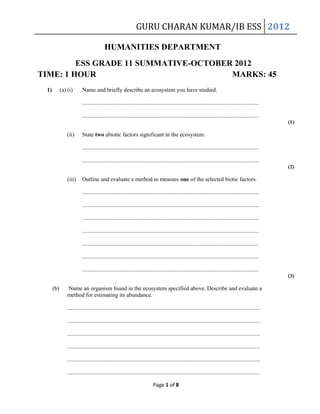
Ess grade 11 summative october 2012
- 1. GURU CHARAN KUMAR/IB ESS 2012 HUMANITIES DEPARTMENT ESS GRADE 11 SUMMATIVE-OCTOBER 2012 TIME: 1 HOUR MARKS: 45 1) (a) (i) Name and briefly describe an ecosystem you have studied. ........................................................................................................................... ........................................................................................................................... (1) (ii) State two abiotic factors significant in the ecosystem. ........................................................................................................................... ........................................................................................................................... (2) (iii) Outline and evaluate a method to measure one of the selected biotic factors. ........................................................................................................................... ........................................................................................................................... ........................................................................................................................... ........................................................................................................................... ........................................................................................................................... ........................................................................................................................... ........................................................................................................................... (3) (b) Name an organism found in the ecosystem specified above. Describe and evaluate a method for estimating its abundance. ...................................................................................................................................... ...................................................................................................................................... ...................................................................................................................................... ...................................................................................................................................... ...................................................................................................................................... ...................................................................................................................................... Page 1 of 8
- 2. GURU CHARAN KUMAR/IB ESS 2012 ...................................................................................................................................... (4) Two areas of forest each contain 50 trees. The species composition of the two areas is as follows. Area A Eucalyptus 42 25 Casurina (c) Area B 8 25 Simpson’s diversity index can be calculated by applying the formula below, D= where: N ( N 1) n( n 1) N = total number of organisms of all species, n = number of organisms of a particular species. (i) Calculate Simpson’s diversity index for area B (showing your working). ........................................................................................................................... ........................................................................................................................... ........................................................................................................................... ........................................................................................................................... ........................................................................................................................... (3) (ii) Simpson’s diversity index for area A is 1.38. Suggest a reason for the difference between the values for these two areas. ........................................................................................................................... ........................................................................................................................... (1) Page 2 of 8
- 3. GURU CHARAN KUMAR/IB ESS 2012 iii) With the help of a diagram, state what is meant by the term food-chain. ................................................................................................................................................ ................................................................................................................................................ ( 2 marks) (Total 16 marks) 2) (a) Distinguish between the terms predator and parasite. ...................................................................................................................................... ...................................................................................................................................... ...................................................................................................................................... ...................................................................................................................................... (2) 80 parasites 10 herbivores 100 producers (b) (i) State the name of the type of diagram shown above. ........................................................................................................................... (1) Page 3 of 8
- 4. GURU CHARAN KUMAR/IB ESS 2012 (ii) Suggest why there are often more organisms at the third trophic level than at the second trophic level in a food chain containing parasites. ........................................................................................................................... ........................................................................................................................... ........................................................................................................................... (2) (c) Explain why the energy available to the predators in a food chain is much less than that fixed by the producers. ...................................................................................................................................... ...................................................................................................................................... ...................................................................................................................................... ...................................................................................................................................... ...................................................................................................................................... ...................................................................................................................................... ...................................................................................................................................... (4) (Total 9 marks) Page 4 of 8
- 5. GURU CHARAN KUMAR/IB ESS 2012 3) Figure 1 shows a simplified food web for the North Sea in Europe. Figure 1 Insolation from sun (solar energy) Surface of sea Euphotic zone (light available for photosynthesis) Mineral nutrients in solution Seabirds ( e.g. puffin, gannet) Seals Phytoplankton Zooplankton Mackerel Jellyfish - - - - - - - - - - - - -Sand-eels- - - - - - - - ----------------------------------------- -Carbon dioxide dissolved in seawater Herring Dolphins Squid Demersal fish ( e.g. cod, haddock) Crustaceans ( e.g. crabs, lobsters) Continental shelf Benthic zone (sea bed) Detritus (decaying organic material) SEDIMENT [Adrian Kidd, Managing Ecosystems, (Hodder & Stoughton, 1999) p. 41; p. 72. © Hodder and Stoughton. Reproduced by permission of Hodder & Stoughton Ltd.] (a) (i) Complete the table below by assigning each of the following types of organisms from Figure 1 to its correct trophic level. jellyfish, crustaceans, dolphins, zooplankton, puffins, phytoplankton Producer Primary Consumer Secondary Consumer Tertiary Consumer Decomposer (3) (ii) Explain why there is a limit to the number of trophic levels which can be supported in an ecosystem. ........................................................................................................................... ........................................................................................................................... ........................................................................................................................... ........................................................................................................................... Page 5 of 8
- 6. GURU CHARAN KUMAR/IB ESS 2012 (3) (iii) In the 1970s sand eels were harvested and used as animal feed, for fishmeal and for oil and food on salmon farms. State and explain what impacts a dramatic reduction in the number of sand eels might have on the rest of the ecosystem. ........................................................................................................................... ........................................................................................................................... ........................................................................................................................... ........................................................................................................................... ........................................................................................................................... ........................................................................................................................... ........................................................................................................................... (4) (Total 10 marks) Page 6 of 8
- 7. GURU CHARAN KUMAR/IB ESS 2012 4) The figure below shows a simple aquatic food chain which has been exposed to a pesticide called DDT. Land progressive sequence Milk Meat Aquatic progressive sequence Humans, the ultimate accumulators Third carnivore (larger fsh) Second carnivore (larger fsh) Grazing animals First carnivore (larger fsh) Herbivore (smaller fsh) First accumulator (algae, water plants) Grass Pollutant in molecular form DDT spray [Source: Adapted from Goudie, A (1993) The Human Impact on the Natural Environment, Blackwell, p.219] (a) (i) State how many trophic levels are shown in the figure above. ........................................................................................................................... (1) (ii) Identify which trophic level represents: the producers ..................................................................................................... the top carnivores .............................................................................................. (1) (iii) State and explain what may be happening to the concentration of pesticide in the food chain. ........................................................................................................................... ........................................................................................................................... ........................................................................................................................... ........................................................................................................................... (2) Page 7 of 8
- 8. GURU CHARAN KUMAR/IB ESS 2012 (b) An estimated 1000 kg of plant plankton are needed to produce 100 kg of animal plankton. The animal plankton is in turn consumed by 10 kg of fish, the amount needed by a person to gain 1 kg of body mass. (i) Explain why the amount of biomass declines at each successive trophic level. ........................................................................................................................... ........................................................................................................................... ........................................................................................................................... ........................................................................................................................... (3) (ii) Distinguish between a pyramid of biomass and a pyramid of productivity. ........................................................................................................................... ........................................................................................................................... ........................................................................................................................... ........................................................................................................................... (3) (Total 10 marks) Page 8 of 8
